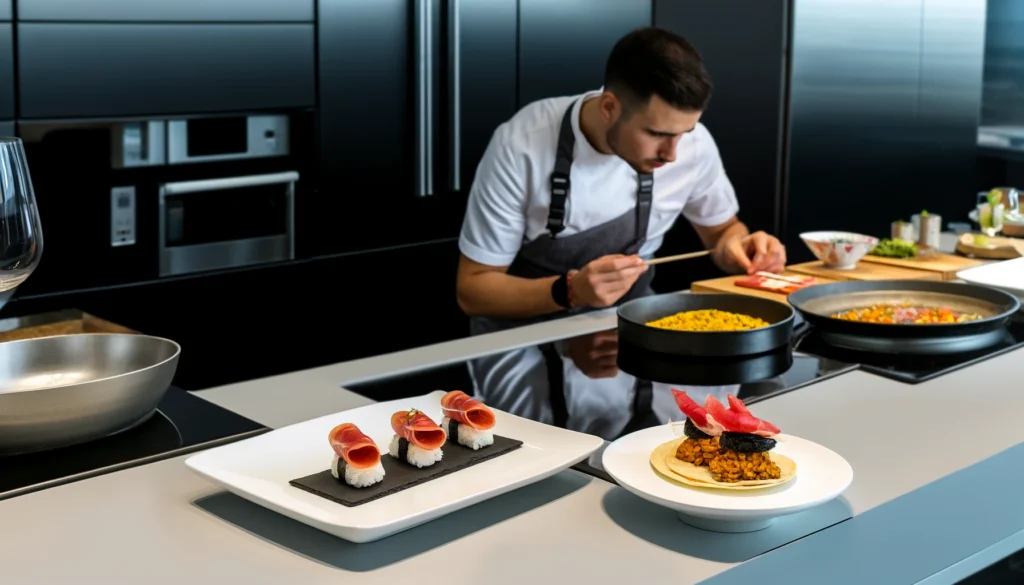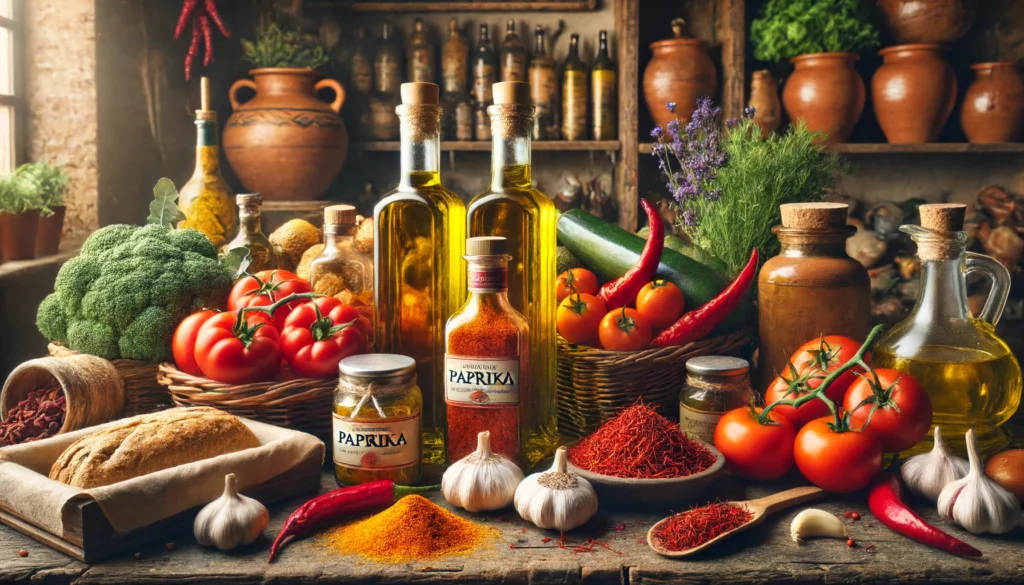Food in Spanish is an universal language that unites cultures and brings people closer together. We explore a rich tapestry when we discuss food, in Spanish. This includes flavors, stories, and traditions from all over Spain, Latin America and beyond. This article is for anyone who loves to travel, enjoys food, or wants to learn more about other cultures.
Table of Contents
Food in Spanish The following is a brief introduction to the topic:
food in Spanish When we imagine cuisine in Spanish we usually picture vibrant plates with bold flavors and a sense of tradition. Spanish cuisine celebrates life and culture. From the smoky smell of paprika that comes from a perfectly grilled chorizo, to the delicate sweetness in a freshly baked churro. This article will explore the diverse dishes and regional variations, as well as the rich history that makes Spanish cuisine so popular around the globe.
Spanish Cuisine: A Short History

food in Spanish The Spanish cuisine is a fusion of cultures, shaped over centuries by the history of the Iberian Peninsula and its inhabitants. Spain’s culinary landscape has been shaped by the Romans, Moors, and the discovery of the Americas.
Roman Influences The Romans introduced wine and olive oil, which are staples of Spanish cuisine today. With their advanced agricultural techniques, the Moors introduced new ingredients to Spanish cuisine, such as rice, saffron and almonds.
Discovery of the Americas The arrival of ingredients such as chocolate, tomatoes, peppers and potatoes from the New World in the 15th century marked the beginning of a new age. These ingredients were rapidly integrated into Spanish cuisine, revolutionizing it.
Spanish Traditional Dishes

Paella : The Valencia region is home to the paella, arguably the most popular Spanish dish. This rice dish can be cooked in a shallow, wide pan with ingredients like seafood, chicken or rabbit. It is flavored with saffron, paprika, and other spices.
Gazpacho and Salmorejo are the perfect chilled soups for summer heat. Gazpacho is a refreshing mixture of tomatoes, cucumbers and peppers. Salmorejo is a thicker version that’s often topped off with jamon or hard-boiled egg.
Tortilla espanola This simple but hearty dish, also known as Spanish Omelette, is made from eggs, potatoes and onions. This dish is often served hot or cold as a tapa, main course or dessert.
Jamon Iberico This cured ham, a Spanish staple for charcuterie, is an exquisite product. It’s a ham made from Iberian pork, and is prized for the delicate texture and rich flavor. Jamon Iberico is often enjoyed on its own or with bread.
Regional Varieties

The geographical diversity and cultural diversity of Spain contribute to the wide variety of regional cuisines. Each region has its specialties that reflect local ingredients and traditions.
Catalonia Known for the rich and varied food of Catalonia, dishes include Escudella – a meat and vegetable stew – and Crema Catalana – a delicious custard similar to creme brulee.
Basque Country The Basque country is famous for its seafood and pintxos. The coastal bounty is highlighted by dishes like Bacalao de la Vizcaina, a salted cod dish in a tomato-red pepper sauce.
Andalusia : The cuisine of Andalusia is heavily influenced from its Moorish heritage. You’ll also find fried fish, or “pescaito Frito”, and other tapas.
Galicia In the northwest of Spain, Galicia has a reputation for its seafood. The Galician octopus, Pulpo a la Gallega, is a must try. It’s seasoned with olive oil and paprika. Empanadas stuffed with seafood or meat are another culinary highlight.
Spanish Tapas – Small Bites with Big Flavor

Tapas in Spain are much more than appetizers. They’re a lifestyle. They are ideal for sharing, and can be anything from simple olives or elaborate preparations.
Classic Tapas Among the most popular tapas are Patatas Bravas, Albondigas and Gambas al Ajillo. Each tapa is bursting with flavor and usually served with a beer or wine.
Modern Tapas : Modern chefs have taken tapas and elevated it to a new level, using global ingredients and innovative methods. Modern tapas are characterized by fusion flavors and creative presentation. They reflect the dynamic nature of Spanish food.
The Influence of Spanish cuisine in Latin America

Spanish explorers brought their culinary tradition with them when they set sail to the New World. These influences, combined with native ingredients and cooking techniques, created the varied and delicious cuisines of Latin America.
Mexico : Spanish settlers brought ingredients such as wheat, livestock and spices to the native food, resulting in dishes like tacos and tamales.
Peru : Peruvian food combines Spanish, indigenous and other influences. Ceviche, a raw fish marinated in Spanish techniques, is a dish that combines local ingredients and Spanish techniques.
Argentina : Spanish and Italian immigrants have heavily influenced Argentine food. The Spanish introduced meats and grilling methods that are essential to Argentine barbecue (asado).
Fusion and Modern Takes On Spanish Food

Spanish cuisine is evolving. Chefs around the globe are reimagining and creating traditional dishes, while also incorporating Spanish flavors into new dishes.
Molecular Gastronomy. Spain has been a leader of this avant-garde movement in the culinary world, in part thanks to chefs such as Ferran Adria from El Bulli. Techniques such as spherification, foam creation and aeration have changed the way we experience food.
Global Fusion : Spanish flavors are now part of global cuisine. The fusion of Spanish cuisine and other culinary traditions has resulted in innovative and exciting dishes, from sushi topped with Jamon Iberico and tacos filled paella.
Popular Spanish Ingredients

Spanish cuisine is known for its fresh and high-quality ingredients. Here are some of the staples that you will find in Spanish cuisine:
Olive Oil is a cornerstone in Spanish cuisine. It’s used to fry, saute, and for dressing. Spain is the world’s largest producer of olive oil.
Saffron This precious spice gives dishes such as paella their distinct color and flavor. It is harvested from crocus flowers and is among the most expensive spices in terms of weight.
Paprika Paprika is also known as pimenton (in Spanish), and adds a smoky or sweet kick to many dishes. It is made of dried and ground red peppers.
Garlic and Onions are essential to many Spanish dishes, adding depth and flavor to stews, sauces and more.
Food Festivals in Spanish Speaking Countries

Numerous food festivals are held in Spanish-speaking nations to celebrate their rich culinary tradition. These festivals offer the chance to try a variety of foods and learn about local culture.
La Tomatina (Spain). This famous tomato-throwing event is held in Bunol. It’s not just a feast for your eyes, but also a celebration the humble tomato.
Mistura, Peru: Mistura is one of Latin America’s biggest food festivals. It brings together chefs, food lovers, and farmers to celebrate Peruvian food.
Feria de Abril (Spain). This spring fair is famous for its tapas, seafood and other food. This is a wonderful opportunity to sample a wide variety of Andalusian cuisines.
Festival Internacional de la Gastronomia de México This international food festival celebrates the rich culinary history of Mexico, and includes dishes from all over the world.
Spanish Food Etiquette

It is important to understand the food customs of Spanish-speaking countries. Here are some tips for navigating mealtime customs.
Tapas Etiquette : It is customary to pass dishes around the table when enjoying tapas. Do not hesitate to sample a little bit of everything. Always pass the plates.
Spanish Meal Times Spanish meal times tend to be later than other cultures. Lunch is usually served between 1:30 PM and 3:30 PM and dinner may start as late at 9 PM.
Table Manners It is polite to use bread to scoop food or sauce up from the table.
Toasting : Make eye contact with everyone and say “Salud!” prior to taking a drink. This is a sign of friendship and good health.
Spanish Cuisine at Home

It’s easier than you think to bring the tastes of Spanish cuisine into your own home kitchen. You can make delicious Spanish food with a few basic ingredients and techniques.
Essential Equipment A paella pan is a must-have for Spanish cooking. Also, you’ll need a good mortar and pestle to grind spices and a chef’s sharp knife.
Simple recipes: Start by making simple dishes such as gazpacho and tortilla Espanola. These recipes are easy to prepare and require few ingredients.
Exploring regional recipes As you gain more confidence, try out more complex dishes, such as the Catalan seafood stew, or a Galician Empanada.
Spanish cuisine has many health benefits

Spanish cuisine offers many health benefits. The emphasis on natural, fresh ingredients and well-balanced meals make it a healthy option.
Mediterranean Diet Many traditional Spanish recipes are part of the Mediterranean Diet, which promotes heart health and long life. This diet emphasizes fruit, vegetables, whole grain, and healthy fats such as olive oil.
High in Antioxidants Ingredients such as tomatoes, peppers and garlic contain high levels of antioxidants that can reduce inflammation and help protect against chronic disease.
Moderate Portion: Spanish food is often served in smaller portions and more frequently, which helps maintain a healthy body weight.
Conclusion

Explore cuisine in Spanish and you will be taken on a journey of diverse flavors, rich ingredients, deep-rooted customs, and rich traditions. You’re part of a culinary tradition that spans continents, centuries, and even continents. Whether you are eating tapas at a busy Spanish bar, or enjoying ceviche on the coast of Peru, or making paella in your own home, you will be participating in this culinary tradition. Spanish food is a way to bring people together and tell stories. It’s also a great way to enjoy life.
FAQs
1. The most popular Spanish foods include gazpacho and Jamon Iberico. These dishes offer a taste of Spain’s culinary history.
2. Spanish cuisine has influenced Latin American cuisines in a big way. It has blended with local ingredients and customs to create new, vibrant culinary styles. This fusion is evident in dishes like ceviche and tacos.
3. Spanish tapas, or small dishes are ideal for sharing. The most popular tapas are Patatas Bravas and Albondigas.
4. How does the Mediterranean diet relate to Spanish cuisine? It emphasizes healthy fats, such as olive oil, fruits, vegetables and whole grains. This diet is known for the health benefits it offers. Many Spanish dishes such as those that feature seafood and olive oils are included in this diet.
5. You can cook many Spanish dishes at home using basic kitchen equipment. Start with easy recipes such as gazpacho and tortilla Espanola to get a taste of Spanish cuisine.

1 thought on “food in SpanishExplore the vibrant world of”